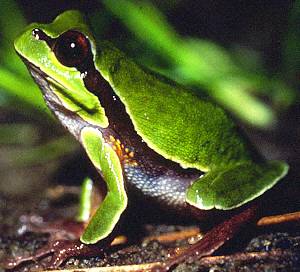|
This species has many unique identifying characteristics
- a nasal, honking "quonk-quonk-quonk" call, vibrant coloration,
a tiny inch and a half long body, and an appetite for mosquitoes. They
are also found in a specific type of habitat - sandy, acidic and mucky
soils that offer dense shrubs, heavy ground cover, and shallow ponds,
bogs and ditches for breeding needs.
The Pine Barrens treefrog was first described in New
Jersey, and in the state occurs only in what is now known as the Pinelands.
What's most unique about the species this year though, is that it has
been "down-listed" - which is a good thing!
Recognized in New Jersey as an endangered species
since 1979, the status of the Pine Barrens treefrog has been upgraded to "threatened"
due to being locally abundant in some areas of New Jersey where this treefrog
is known to occur - another success story in New Jersey.
|
 Pine Barrens Treefrog
Pine Barrens Treefrog
Photo courtesy of Blaine Rothauser |